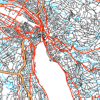Road network selection for small-scale maps using an improved centrality-based algorithm
Keywords:
map generalization, road network selection, strokes, network centrality, betweenness centralityAbstract
The road network is one of the key feature classes in topographic maps and databases. In the task of deriving road networks for products at smaller scales, road network selection forms a prerequisite for all other generalization operators, and is thus a fundamental operation in the overall process of topographic map and database production. The objective of this work was to develop an algorithm for automated road network selection from a large-scale (1:10,000) to a small-scale database (1:200,000). The project was pursued in collaboration with swisstopo, the national mapping agency of Switzerland, with generic mapping requirements in mind. Preliminary experiments suggested that a selection algorithm based on betweenness centrality performed best for this purpose, yet also exposed problems. The main contribution of this paper thus consists of four extensions that address deficiencies of the basic centrality-based algorithm and lead to a significant improvement of the results. The first two extensions improve the formation of strokes concatenating the road segments, which is crucial since strokes provide the foundation upon which the network centrality measure is computed. Thus, the first extension ensures that roundabouts are detected and collapsed, thus avoiding interruptions of strokes by roundabouts, while the second introduces additional semantics in the process of stroke formation, allowing longer and more plausible strokes to built. The third extension detects areas of high road density (i.e., urban areas) using density-based clustering and then locally increases the threshold of the centrality measure used to select road segments, such that more thinning takes place in those areas. Finally, since the basic algorithm tends to create dead-ends—which however are not tolerated in small-scale maps—the fourth extension reconnects these dead-ends to the main network, searching for the best path in the main heading of the dead-end.

Downloads
Published
Issue
Section
License
Copyright (c) 2014 Roy Weiss, Robert Weibel

This work is licensed under a Creative Commons Attribution 4.0 International License.
Articles in JOSIS are licensed under a Creative Commons Attribution 3.0 License.
